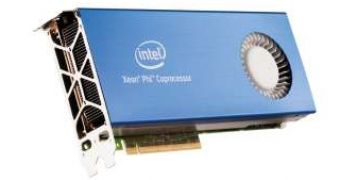We've been doing our best to cover whatever new information arises concerning Intel's Many Core Architecture (MIC) products, but what we haven't done yet is take a close look at who or what they will be faced against.
Xeon Phi is Intel's second attempt at offering supercomputer and data center makers an alternative to GPU computing.
The first project was the x86 GPU Larrabee, but it got canceled due to inability to catch up to the times, let alone surpass the NVIDIA and AMD GPUs it was supposed to remove from the equation.
Xeon Phi is different in that, rather than being a genuine GPU compute accelerator, it is actually a PCI Express card equipped with a number of x86 CPU cores.
Back at the start of the month (August 1, 2012), we provided the specifications of the B0 stepping configurations: 57C, 60C and 61C.
The strongest (57C) was rated at 1.1 GHz for the x86 cores, which would seem like a lot for something with up to 62 of them.
However, a new report has arisen, one that says Xeon Phi will go up to 1.3 GHz, not just 1.1 GHz. That way, it will match NVIDIA's upcoming GK110 graphics processor (Kepler).
The only reason this hasn't happened yet is a supposed problem with yields. Manufacturing cards with the necessary core count and frequency hasn't been going all that smoothly apparently, and Intel is aiming to fix this as fast as possible.
After all, it wouldn't do to waste the manufacturing process advantage: Intel Xeon Phi uses the 22nm node while NVIDIA, and AMD for that matter, make their chips on TSMC's 28nm.
Speaking of which, Xeon Phi matches AMD's FirePro W9000 card. While Xeon Phi has more RAM (8GB on 512-bit bus over 6GB on 384-bit), W9000 benefits from PCI Express 3.0 (Phi has only PCIe 2.0).
Ultimately, if Intel succeeds in increasing the frequency, it could seriously mess up AMD's and NVIDIA's HPC contracts, due to the x86 architecture already supporting many programs run by supercomputers that can't use GPU parallel processing yet.

 14 DAY TRIAL //
14 DAY TRIAL //